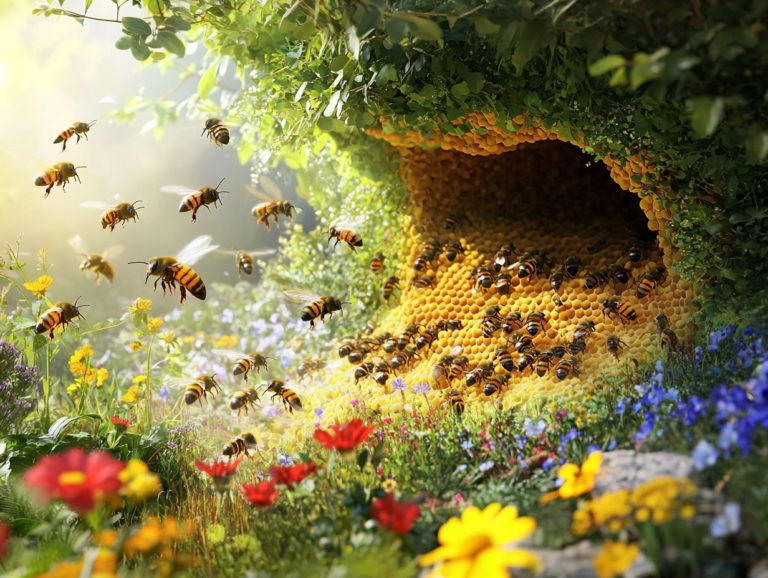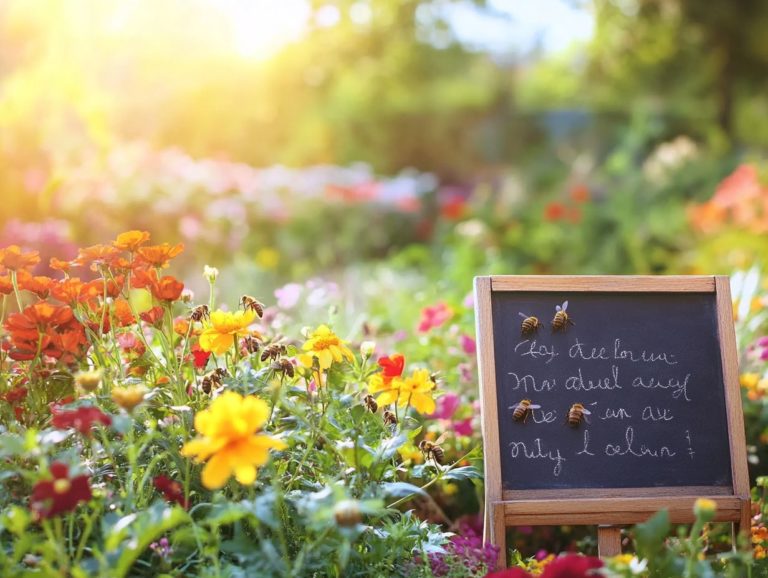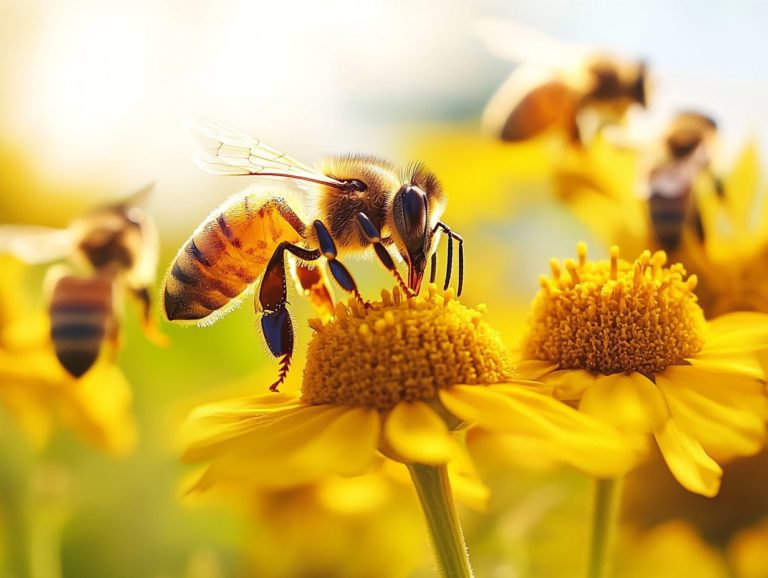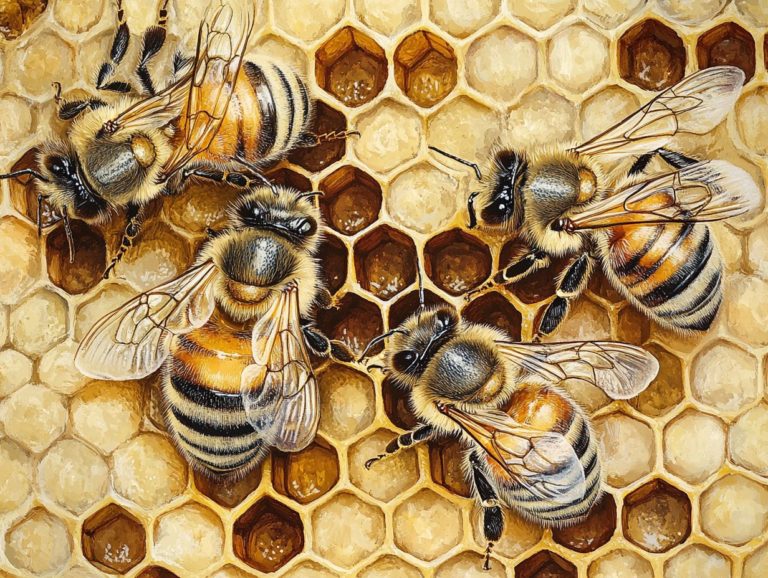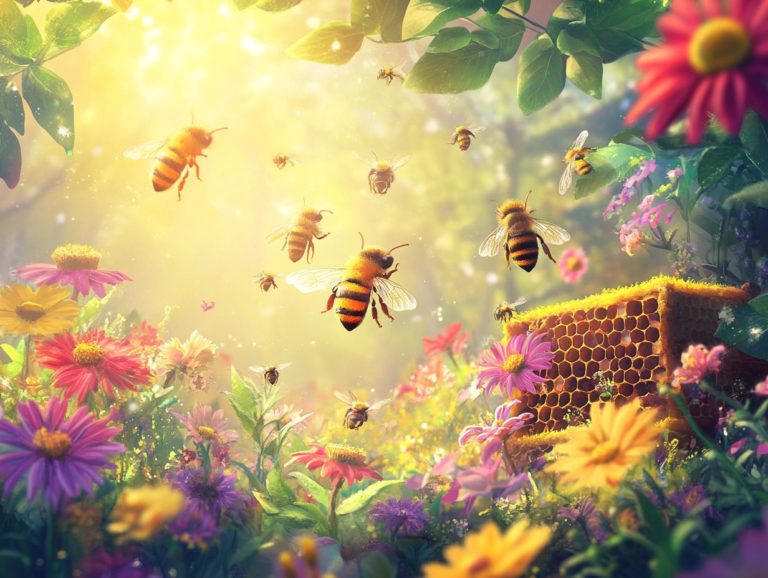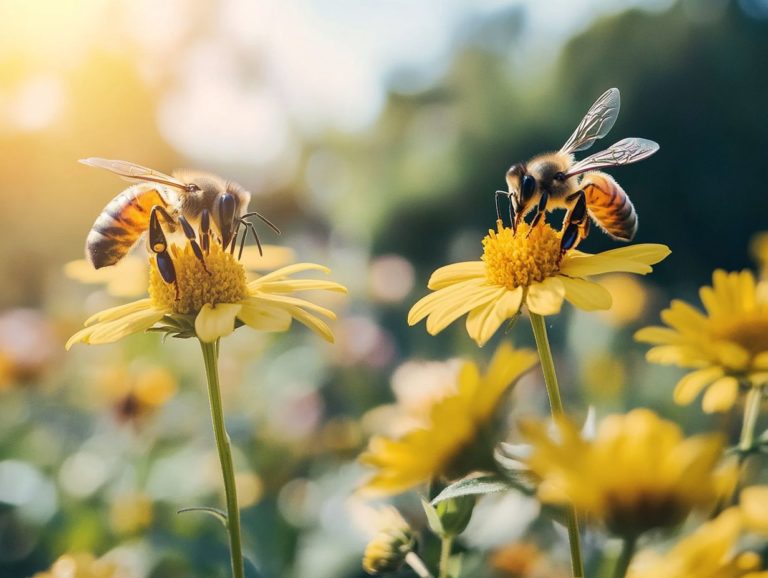The 7 Types of Bees Found in Gardens
Bees are essential to maintaining a flourishing garden ecosystem. Gaining insight into the various types of bees can significantly elevate your gardening experience. Pollinators, creatures that help plants reproduce by transferring pollen, include honey bees, bumble bees, and solitary bees.
From the diligent honey bee to the solitary mason bee, each species plays a unique role in pollination and contributes to the overall health of your plants. Bees play crucial roles in a garden ecosystem, such as pollination, maintaining biodiversity, and contributing to ecosystem stability.
This article delves into seven fascinating types of bees that frequently visit gardens, highlighting their distinct characteristics, functions, and the invaluable benefits they provide. Understanding different bee families such as Apidae, Halictidae, and Megachilidae can enhance this knowledge.
You can also enhance their habitat by planting native flowering plants while addressing the challenges they encounter, such as habitat loss and species decline. Get ready to explore the buzz-worthy world of bees! These incredible creatures don t just pollinate they can transform your garden into a blooming paradise!
Contents
- Key Takeaways:
- 1. Honey Bees
- 2. Bumble Bees
- 3. Mason Bees
- 4. Carpenter Bees
- 5. Sweat Bees
- 6. Leafcutter Bees
- 7. Mining Bees (Andrenidae)
- What Are the Roles of Bees in a Garden Ecosystem?
- How to Attract and Support Different Types of Bees in Your Garden
- What Are the Threats to Bee Populations and How Can They Be Addressed?
- What Are the Benefits of Having Bees in a Garden?
- How Do Different Types of Bees Contribute to Pollination?
- What Are Some Interesting Facts About Bees (Apidae, Halictidae, Megachilidae, Andrenidae, Colletidae, Melittidae, Stenotritidae)?
- Frequently Asked Questions
Key Takeaways:
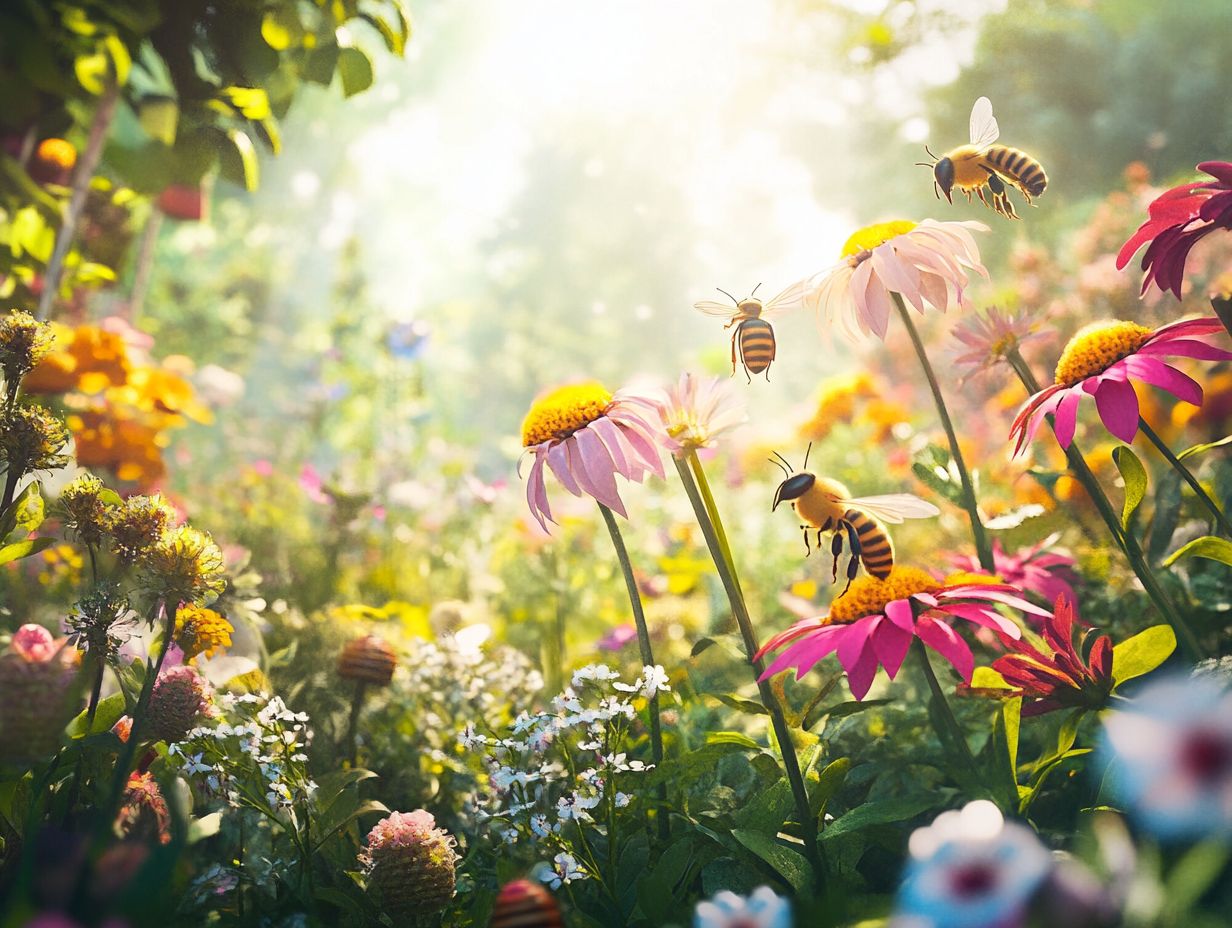
- Honey Bees, Bumble Bees, Mason Bees, Carpenter Bees, Sweat Bees, Leafcutter Bees, and Mining Bees are the 7 types of bees commonly found in gardens.
- Gardeners can attract and support different types of bees by providing a variety of flowering plants and avoiding the use of pesticides.
1. Honey Bees
Honey bees, part of the Apidae family, are among the most crucial pollinators in the world, playing a critical role in maintaining the health of our ecosystems through their remarkable contribution to the pollination of flowering plants. These remarkable insects, including well-known species like the European Honey bee and Asian Honey bee, are celebrated for their intricate social structures and building complex hives that facilitate the production of honey a sweet nectar transformed through their unique behaviors.
Beyond their pollination duties, these bees exhibit interesting behaviors like foraging, communicating through intricate dances, and maintaining a meticulous hierarchy within the hive. The roles of the queen, workers, and drones are distinct yet interdependent, ensuring the hive’s survival and productivity.
As a gardener, you hold the power to attract these beneficial insects by planting a diverse array of nectar-rich flowers and providing suitable habitats. Simple actions, such as creating bee-friendly spaces, steering clear of pesticides, and ensuring a consistent water source, can significantly enhance the local honey bee population. By planting diverse, nectar-rich flowers, you ensure a thriving garden and a healthy bee population.
Their presence not only boosts crop yields but also enriches the biodiversity essential for a thriving environment. Act now to become a bee-friendly gardener! Your efforts can greatly impact these vital pollinators and contribute to the delicate balance of nature that sustains us all.
2. Bumble Bees
Bumble bees are essential pollinators. They have fuzzy bodies and a remarkable ability to pollinate many types of flowering plants. Bumble bees play a crucial role in keeping ecosystems healthy and supporting agriculture. They belong to the Apidae family, just like honey bees.
Among the many species, you ll find the Garden Bumble Bee and the Common Eastern Bumble Bee buzzing around gardens. The Cuckoo Bumblebee, Red-tailed Bumblebee, and White-tailed Bumblebee each bring their unique flair to the pollination scene. Their role in supporting biodiversity is vital for thriving ecosystems.
Each species has its own distinct nesting preferences. Some choose to settle in abandoned rodent burrows or cozy spots in dense grass. Others prefer above-ground nests tucked away in thick vegetation. For example, the Hairy-Footed Flower Bee likes solitary nests in soft soil.
Create inviting habitats by leaving undisturbed patches of lawn or adding native flowering plants. You can attract these invaluable pollinators.
Ensure a variety of bloom times throughout the seasons. This provides a consistent food source, allowing these bees to flourish. Supporting their well-being also encourages robust plant growth and enhances agricultural productivity.
3. Mason Bees
Mason bees are a type of bee that lives alone instead of in a colony. They are exceptional pollinators known for their unique nesting habits. Unlike social bees like honey and bumblebees, they build individual nests using mud found in small crevices. These remarkable bees play a critical role in pollinating early-blooming flowers, enhancing biodiversity, and supporting healthy ecosystems. Recognizing mason bees is enlightening for both gardeners and nature enthusiasts.
As you observe these industrious insects, you ll discover fascinating insights into their lifecycle. Female mason bees collect pollen and nectar for their larvae, sealing each compartment with mud. They are essential pollinators, efficiently fertilizing fruit trees and various wildflowers, which aids in food production and maintains ecological balance.
To attract mason bees, set up small bee houses filled with paper straws or hollow reeds. Ensure they have access to mud for nest building. Planting native flowers that bloom in early spring provides essential food resources, transforming your garden into a haven for these extraordinary pollinators.
4. Carpenter Bees
Carpenter bees are a remarkable species with stout bodies and intriguing behaviors. They create nests by boring into wood. This behavior can be fascinating, but it may also worry homeowners. Unlike honey bees, carpenter bees are solitary creatures. They are essential pollinators, particularly for flowering plants that need specialized techniques for pollination.
Understanding carpenter bees’ behaviors and nesting preferences helps you appreciate their contribution to maintaining a diverse ecosystem.
These bees prefer untreated or weathered wood for nesting. If their activities go unchecked, you might observe noticeable damage to your decks, fences, and wooden structures. On the bright side, their presence can lead to a flourishing garden, as they excel at pollinating flowers, significantly boosting your fruit and vegetable yields.
Take preventive measures to manage their nesting habits without harming these important insects. Seal surfaces or use natural repellent oils. Allowing these pollinators to coexist safely enhances your garden’s health and supports the broader ecological balance.
5. Sweat Bees
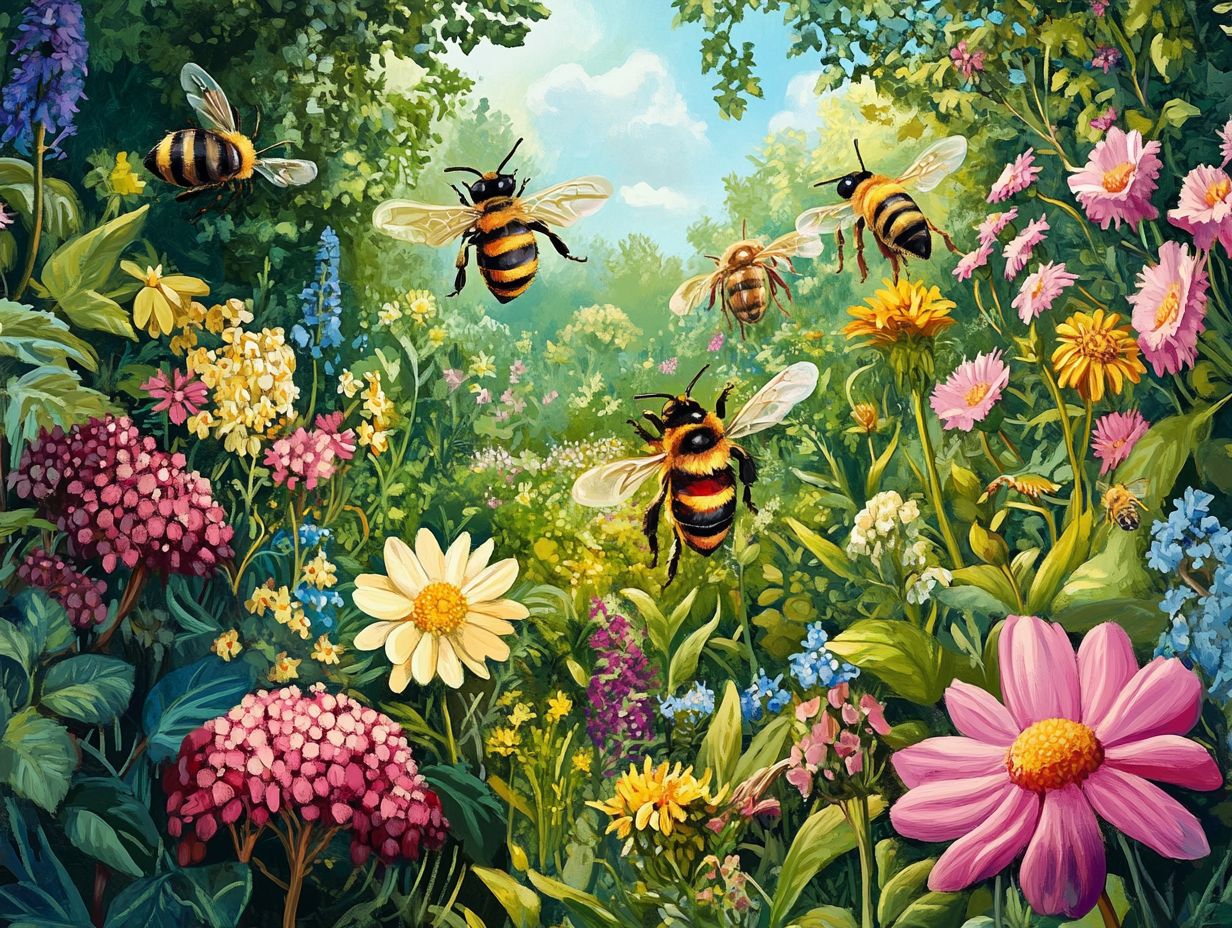
Discover the intriguing world of sweat bees! Sweat bees are part of a family of small bees that are small yet strikingly metallic-looking. They serve as incredibly effective pollinators and thrive in various environments, often buzzing around your flowering gardens.
You might find their peculiar attraction to human sweat quite entertaining. However, their true value lies in their remarkable ability to pollinate numerous plants, thereby supporting the delicate balance of our ecosystems.
By understanding sweat bees and their nesting habits, you can deepen your appreciation for these essential native pollinators. Identifying these intriguing creatures is simple; they usually showcase an array of colors, ranging from green to gold, with iridescent hues that shimmer beautifully in the sunlight.
Their nesting habits are impressively diverse; some prefer to burrow into sandy soil, while others may choose hollow stems or decaying wood. This showcases their adaptability to various environments.
These diligent insects play a significant role in pollinating wildflowers and garden plants, making their presence invaluable in agricultural settings and at home. If you’re keen on attracting sweat bees to your garden, consider taking the following steps:
- Plant native flowering plants,
- Provide sandy patches for nesting, and
- Avoid using chemical pesticides.
By doing so, you’ll foster a vibrant and diverse community of pollinators. Act now to create a buzz in your garden and enhance the beauty and productivity of your space!
6. Leafcutter Bees
Meet the incredible leafcutter bees! Leafcutter bees are part of a family known for their leaf-cutting habits and are truly remarkable pollinators. They are renowned for their unique leaf-cutting behavior, which sets them apart from other bee species, making them fascinating allies in the world of ecology.
These industrious bees play a pivotal role in maintaining healthy ecosystems by pollinating a wide array of plants and enhancing biodiversity. By understanding their nesting habits and foraging behaviors, you can appreciate the vital contribution they make to sustainable agriculture and the overall health of your garden.
Their preference for soft, broad-leaved plants allows them to expertly slice leaves into manageable pieces. They transport these pieces back to their nesting sites with impressive precision. Many of these bees are particularly drawn to flowering plants such as clover, daisies, and various herbs, offering not only abundant pollen but also an irresistible nectar source.
To attract leafcutter bees, create a welcoming environment by planting a diverse range of native flowering species and steering clear of pesticides. Provide small, bare patches of soil or leave wooden blocks for nesting. This will facilitate their nesting, allowing these bees to thrive while significantly enhancing pollination in your garden.
7. Mining Bees (Andrenidae)
Mining bees, members of the Andrenidae family, are captivating ground-nesting solitary bees that play an essential role in pollinating early spring flowers. This makes them invaluable to your garden and local ecosystem. Their unique nesting habits involve burrowing into the ground, which can sometimes lead to confusion with other ground-dwelling insects. By recognizing mining bees and understanding their behaviors, you can deepen your appreciation for these vital pollinators.
Mining bees are just one of many important bee families, including Apidae, Halictidae, Megachilidae, Colletidae, Melittidae, and Stenotritidae. These small, non-aggressive bees often emerge from their underground nests as early as March, just in time for the blooming of key flora like crocuses and dandelions. This perfectly illustrates their specialized role in springtime pollination.
You can identify mining bees by observing their distinctive physical characteristics think fuzzy bodies and a stout size as well as noting their solitary nature compared to social species like honey bees. Other solitary bee species include carpenter bees and leafcutter bees.
To attract these essential pollinators, create ideal habitats by incorporating native plants with staggered bloom times. Leave patches of bare soil for nesting and minimize pesticide use. Providing sources of nectar and ensuring a variety of flowering plants can also support the health of bees. Create a welcoming space for these important pollinators today!
What Are the Roles of Bees in a Garden Ecosystem?
Bees play a multitude of vital roles in your garden ecosystem, primarily as pollinators these are insects that help plants reproduce. They facilitate the reproduction of flowering plants, which is essential for maintaining the stability and health of the ecosystem. The diverse array of bee species, from honey bees to native solitary bees, ensures a robust pollination process that directly influences the yield and variety of the plants you cultivate.
This diversity includes long-tongued bees, short-tongued bees, and medium-tongued bees, each contributing uniquely to pollination success. By understanding these roles, you empower yourself to create environments that nurture bee populations and significantly enhance pollination success.
Different types of bees, including honey bees, bumble bees, and solitary bees, each play a crucial role in this process. Each bee species brings unique contributions to pollinating different types of flowers. Some species have specific preferences for certain plants that others might overlook. This specific preference boosts the genetic diversity of flowering plants and fosters healthier ecosystems where various organisms depend on these plants for food and shelter.
A thriving bee population will yield positive outcomes for your garden s productivity, increasing the chances of fruit and seed development. By cultivating an environment rich in diverse bee species, you can relish the beauty of blooming flowers while actively contributing to the broader biodiversity that sustains local wildlife. Understanding bee behaviors and their preferences can further help create a bee-friendly garden.
Act now to support your local bee populations! Remember, bees are crucial for a flourishing garden and a healthy ecosystem.
How to Attract and Support Different Types of Bees in Your Garden
You can attract and support various types of bees. Create a flourishing garden that meets their essential needs. Different types of bees include honey bees, bumble bees, and solitary bees. By thoughtfully selecting a diverse array of native plants that bloom at different times throughout the growing season, you can provide vital food sources such as nectar and pollen. These resources are crucial for the health and prosperity of bee populations. Implementing bee-friendly practices in your garden can significantly enhance local biodiversity.
To nurture these important relationships, consider grouping your plants in clusters. This simple adjustment makes them more visible to foraging bees. It helps reduce their energy expenditure while they search for food. Incorporating a mix of flower shapes, colors, and sizes elevates your garden’s visual appeal and attracts a broader spectrum of bee species.
Maintaining undisturbed areas of soil offers nesting sites for solitary bees that prefer ground habitats. Avoid pesticides and choose organic gardening techniques to create a safer environment for these vital pollinators.
What Are the Threats to Bee Populations and How Can They Be Addressed?
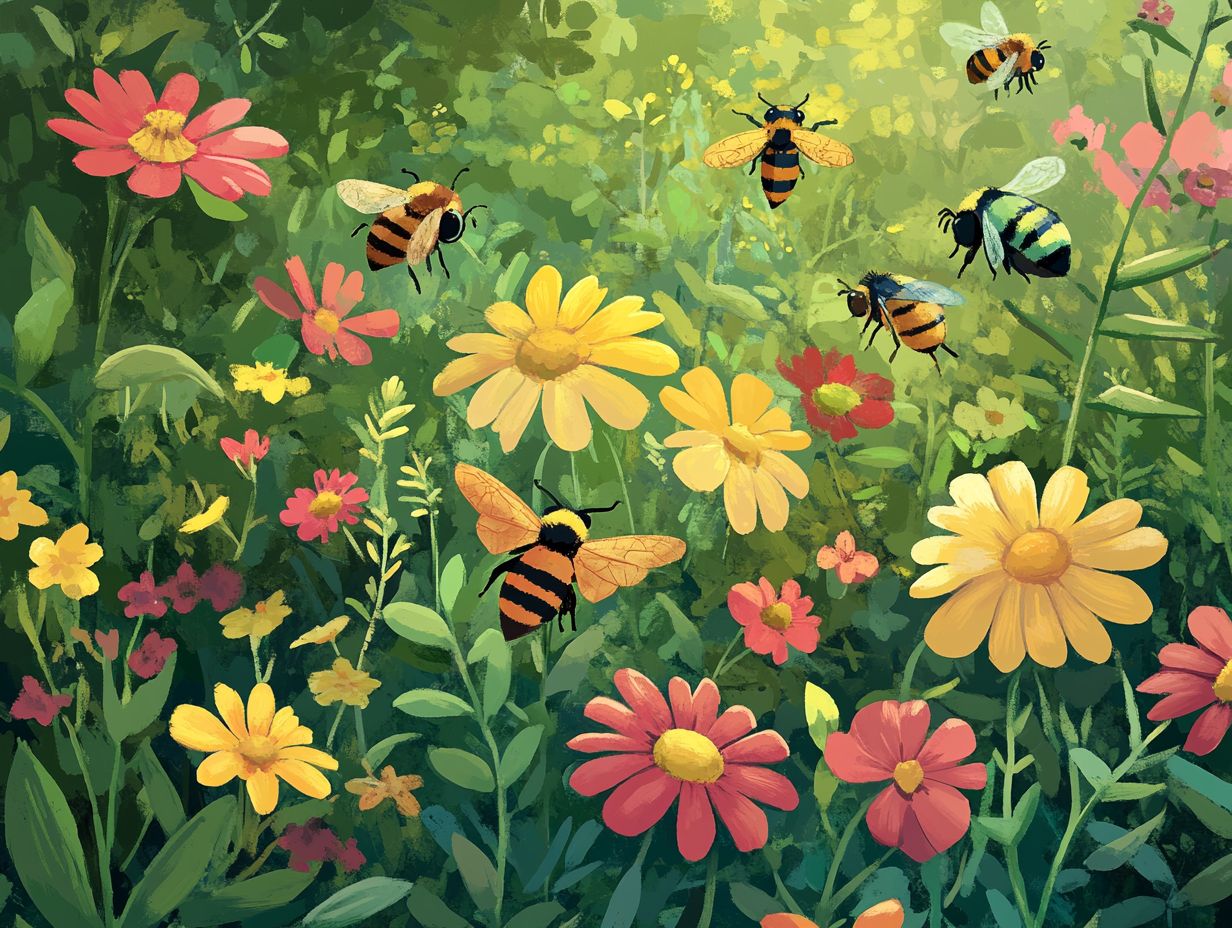
Bee populations are facing considerable threats from species decline, habitat loss, and the environmental repercussions of agricultural practices. Each of these challenges impacts their survival and pollination abilities. To tackle these issues effectively, you must adopt a multifaceted approach. This includes habitat restoration, sustainable farming practices, and raising community awareness about the critical importance of supporting bees. By recognizing these challenges and implementing tangible solutions, you can play a vital role in reversing the decline in bee populations.
The widespread use of pesticides, particularly neonicotinoids, has been directly linked to the decline of various bee species. It is essential for both consumers and farmers to advocate for safer alternatives and stricter regulations. Climate change disrupts flowering patterns and food availability. This impacts bees’ foraging time and success. Urbanization continues to encroach on natural habitats, further reducing nesting sites. The environmental impact of these factors is profound and warrants immediate attention.
Excited to help bees? Here are some impactful ways you can contribute!
- Plant native flowers to provide food and shelter.
- Create pollinator gardens that offer diverse habitats.
- Minimize pesticide use to protect our buzzing friends.
Communities can also take action by organizing educational workshops and collaborating with local farms to promote bee-friendly practices. This ensures these vital pollinators have the resources they need to thrive.
Join us in protecting our buzzing friends! Start your bee-friendly garden today!
What Are the Benefits of Having Bees in a Garden?
Having bees in your garden brings a wealth of benefits. They elevate the pollination of flowering plants and play a crucial role in the productivity and health of your ecosystem. As essential pollinators, bees facilitate the reproduction of a diverse array of plants, enhancing biodiversity and contributing to a thriving garden environment.
This mutual benefit highlights the significance of nurturing habitats that support varied bee populations in your backyard or on a larger agricultural scale. Both native bees and introduced species, like the European honeybee and Asian honeybee, play vital roles in this process.
When these remarkable pollinators flourish, you ll likely see improved yields of fruits and vegetables. Bees expertly transfer pollen, leading to healthier, more robust crops. Their contributions extend beyond just food production; their presence fosters biodiversity, drawing in other beneficial insects that help manage pests naturally.
To create a welcoming environment for bees, consider planting a vibrant mix of nectar-rich flowers that bloom at different times throughout the season. This ensures a consistent food source for them. It s wise to avoid pesticides and provide fresh water sources, like shallow dishes filled with pebbles. Your garden can transform into a thriving sanctuary for these critical creatures. Understanding how to identify bees and their specific needs can further enhance your gardening efforts.
How Do Different Types of Bees Contribute to Pollination?
Different types of bees, such as honeybees, bumble bees, and solitary bees like mason bees and leafcutter bees, each contribute uniquely to pollination. This process is vital for the stability of our ecosystems. Every bee species plays a distinct role in pollinating various flowering plants, ensuring the reproduction and diversity of flora that supports an array of wildlife.
- Honeybees are renowned for their impressive ability to communicate the location of flowers to their hive mates, making them highly effective pollinators for large-scale agriculture.
- Bumble bees thrive in cooler climates and utilize a fascinating technique called buzz pollination, a technique where they vibrate their bodies to release pollen from specific plants like tomatoes and blueberries.
- Solitary bees, like leafcutter bees, have their own preferences for particular plants. They cut leaves to construct their nests and gather pollen from local flora, ensuring their survival.
Other solitary bees, such as the Violet Carpenter Bee and Hairy-Footed Flower Bee, also contribute significantly to pollination. Together, the remarkable behaviors of these diverse bees greatly enhance pollination efficiency and promote biodiversity, underscoring the critical role these insects play in maintaining healthy ecosystems.
Invite these essential pollinators into your garden and watch your plants thrive! Start planting today and create a bee-friendly space!
What Are Some Interesting Facts About Bees (Apidae, Halictidae, Megachilidae, Andrenidae, Colletidae, Melittidae, Stenotritidae)?
Bees are truly remarkable creatures, showcasing a wealth of intriguing behaviors and traits that underscore their vital role as pollinators and champions of biodiversity. For example, did you know that honey bees have the remarkable ability to recognize human faces? Or that solitary bees, like the leafcutter bee, meticulously select specific leaf shapes for their nesting needs? Other interesting species include the Cuckoo Bumblebee and White-tailed Bumblebee. These fascinating facts not only highlight the diversity among bee species but also emphasize their crucial contribution to maintaining healthy ecosystems.
Take the bumblebee, for instance; this species is renowned for its unique technique known as buzz pollination, which enables it to access tightly packed pollen within flowers. This skill benefits the bees with essential nourishment while simultaneously aiding in the fertilization of plants, thereby boosting food production for various species, including humans.
With the alarming decline in bee populations around the globe, understanding these behaviors becomes imperative in fostering their survival. By planting native flowers, minimizing pesticide use, and creating bee-friendly habitats, you can make a significant impact in supporting these critical pollinators and ensuring the health of our environment.
Frequently Asked Questions
What are the 7 types of bees commonly found in gardens?
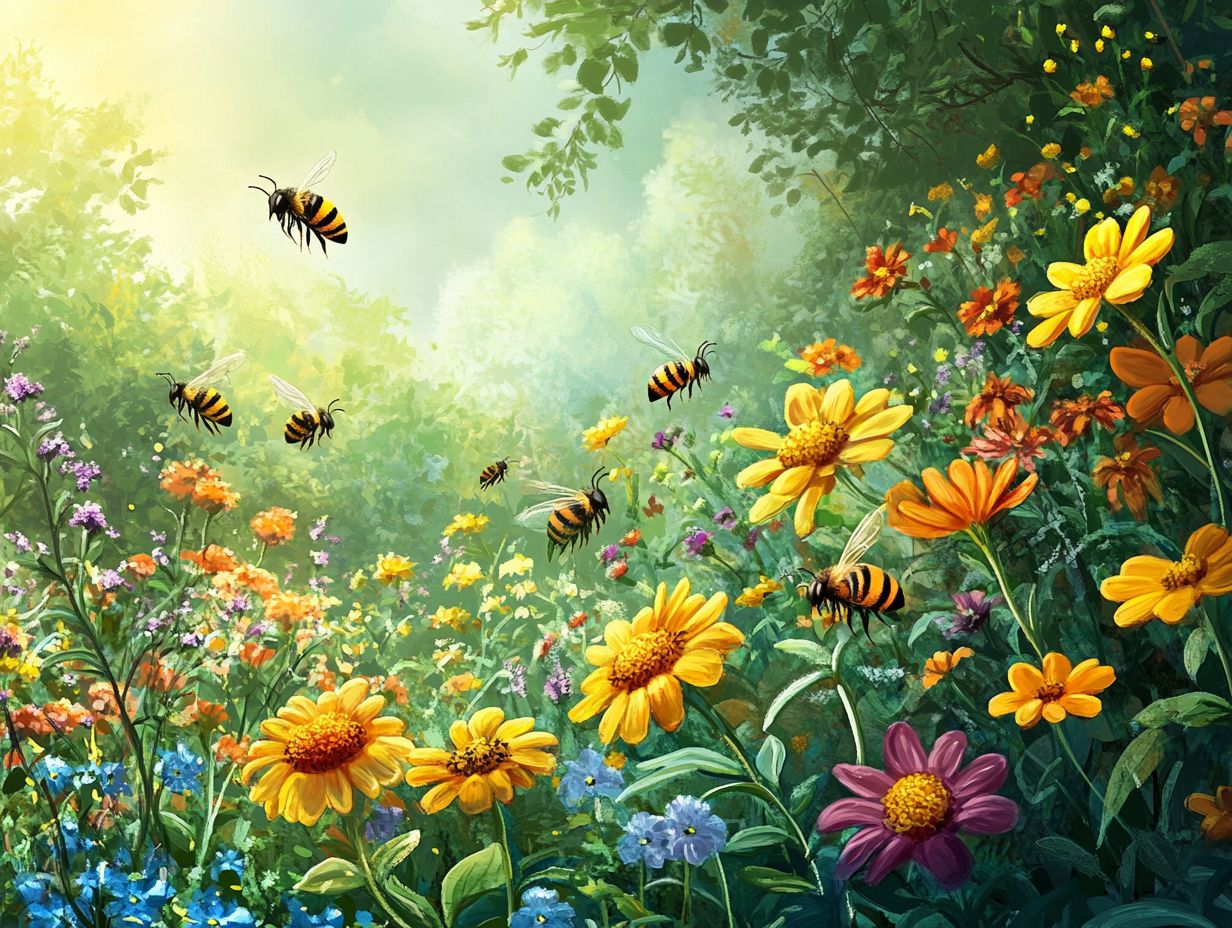
The 7 types of bees commonly found in gardens are honey bees, bumblebees, mason bees, carpenter bees, leafcutter bees, digger bees, and sweat bees.
How do honey bees benefit gardens?
Honey bees are important pollinators and help to increase the yield and quality of fruits and vegetables in gardens.
What makes bumblebees unique compared to other bees?
Bumblebees are larger and hairier than other bees and are known for their ability to buzz pollinate, which helps to release more pollen from flowers.
Do all types of bees live in hives?
No, not all bees live in hives. Honey bees and bumblebees are the only types of bees that live in social colonies, while the other 5 types are solitary bees.
How can I attract bees to my garden?
You can attract bees to your garden by planting a variety of flowering plants and avoiding the use of pesticides. Providing a water source and nesting materials can also help attract bees.
Are bees harmful to humans?
Most bees are not harmful to humans and will only sting if they feel threatened. However, it is important to be cautious around bees and to seek medical attention if you have an allergic reaction to a bee sting.

